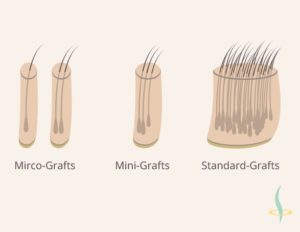Hair Transplantation

Hair transplantation is done under local anesthesia and in outpatient facilities. Small grafts of hair of approximately 5 mm in diameter (so-called standard-grafts) are taken from the back of the head. According to the size of the donor area, up to 120 grafts can be removed for transplantation in one session. The incision made in the donor area from which grafts are taken is subsequently sutured.
The grafts are then split, i.e., the standard-grafts are divided into smaller grafts. These are called mini-grafts (3-5 hairs) and micro-grafts (1-2 hairs). Next, small plugs are removed from the bald area to form recipient sites, and as many as 2000 grafts are implanted into them. Up to 1400 of the smaller grafts are implanted in the gaps created in this way, (up to 4000 hair follicles). The scalp is very vascular, so immediately after the grafts are implanted, the surrounding tissue begins feeding the transplanted tissue, healing begins, and after a few days, the grafts are firmly in place.
Size and arrangement of the individual grafts quite significant in determining the final result later. Here are both experience and creativity of the surgeon is crucial. The goal in each case is a natural-looking hair growth at the site of previous baldness.
What are the best prerequisites for successful hair transplantation?
Provided that your general health is good, you should be a good candidate for hair transplantation. However, we recommend discretion to patients younger than 24 years of age because, at such an early age, hair loss may not yet be complete, and the number of grafts and operations necessary to produce satisfying results is, consequently, difficult to predict.
Occasionally, women are also affected by androgenetic hair loss. In such cases, hair transplantation can also be taken into consideration. However, since hair loss can be the result of a hormone disorder, a complete medical check-up should be made before proceeding.

